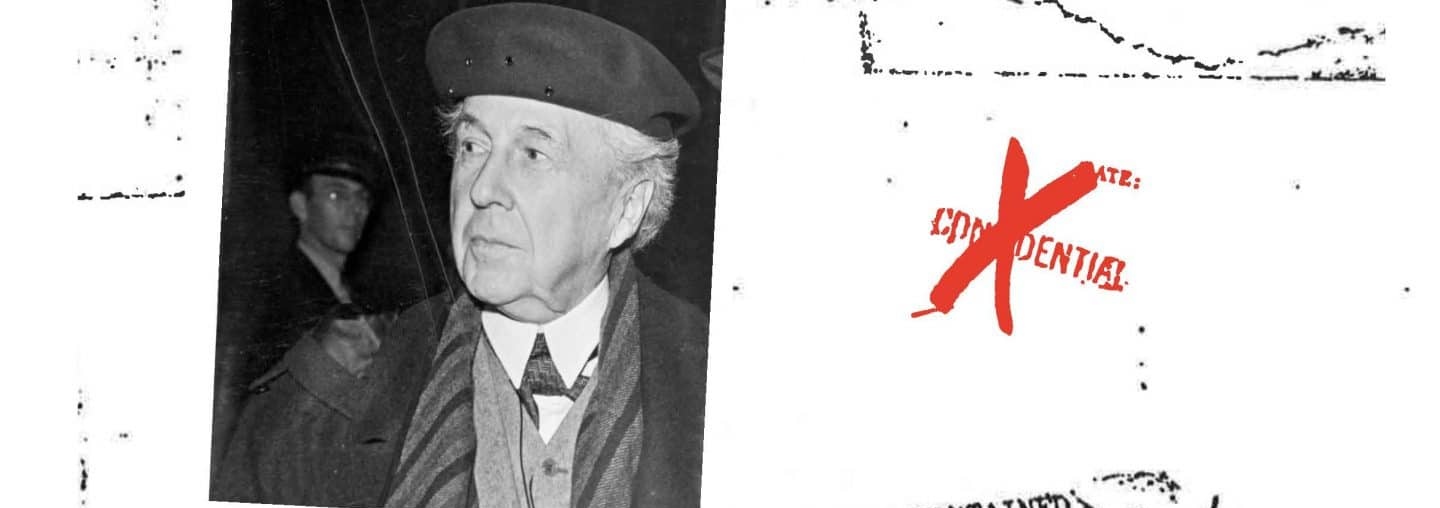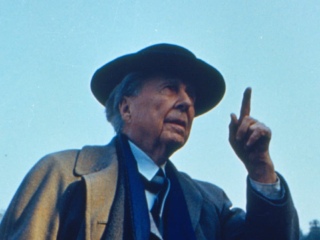
Unwanted Attention: From the FBI Files on Frank Lloyd Wright
Jack El-Hai | May 29, 2018
Journalist Jack El-Hai opens the FBI files on Frank Lloyd Wright and explains the history behind the government’s interest in the architect.
This article originally appeared in, “Elevation,” the Fall 2017 issue of the Frank Lloyd Wright Quarterly. Collages of FBI files with graphic elements designed by Neeta Patel and Ruth Lin.

Famous people—whether they are entertainers, politicians, writers, or artists—know the consequences of celebrity. Along with its benefits, fame brings loss of privacy, attention from complete strangers, and unwanted scrutiny from people in positions of power. And when a celebrity voices unpopular beliefs, the scrutiny of authorities can grow intense.
During the 1940s, Frank Lloyd Wright was the world’s most famous architect and an outspoken proponent of pacifism, anti-authoritarianism, and anti-nationalism in a time of war. It did not take long after America’s involvement in World War II for the sights of the FBI to focus on Wright and his activities at Taliesin in Spring Green, Wisconsin. The result was a fat file of criminal accusations, tips from concerned citizens, news clippings, and details of allegedly suspicious behavior that gave Wright an impressive FBI dossier. The rancor of FBI director J. Edgar Hoover kept his agents adding allegations, real and imagined, to the file for years past the war’s end.
Wright first fell under the FBI’s wartime gaze in December 1942, after federal judge Patrick T. Stone accused the architect of persuading his Taliesin apprentices to avoid the draft by applying for conscientious objector status, thus harming America’s military mobilization. Judge Stone had sentenced one of the apprentices, Marcus Earl Weston, to prison for refusing to report for induction. (Decades later, Weston denied to a reporter that Wright had influenced his decision.) In a memo dated December 17, J. Edgar Hoover asked his Milwaukee bureau to look into the judge’s charges against Wright.

Thanks to citizen informants, the FBI already knew about Wright’s opposition to the war and his sentiments on international affairs. One tipster warned Hoover that Wright “has been sounding off in the worst possible fashion and ought to get his knuckles severely rapped. He’s been making speeches to the effect that we ought to let Japan have what she wants in Asia, they’re really nice people, etc.” Other anonymous letters complained of Wright’s perceived friendliness toward Japan and Germany, and some ascribed to him a hatred of Great Britain.
Hoover forwarded these allegations to U.S. Assistant Attorney General Wendell Berge in a request to prosecute Wright for sedition. The file records that Berge refused to let the case against Wright go further and called for the FBI to end its investigation of the architect.
But Hoover was not about to leave Wright alone. If the architect wasn’t guilty of sedition, then perhaps he could be charged with obstructing the wartime draft. In 1943, a FBI field agent noted in a case report that 26 Taliesin fellows had two years earlier petitioned the draft board in nearby Dodgeville, Wisconsin, for conscientious objector status. “Petitionists [sic] claimed their work as architects in a constructive field was more vital to interior defense than service in the army,” the agent wrote. The draft board had denied their request. The agent interviewed a draft board member, who opined that Wright “was regarded by members of the fellowship as somewhat of an idol, a tin god, or a master, who could do no wrong.” Under Wright’s tutelage, the man continued, the apprentices believed “they could do no wrong and were more or less immune to local restrictions and laws.” In addition, an informant had charged that Wright had once declared that “none of his boys would have to go to war under the conscription act except over his dead body.”

Finally an FBI agent interviewed Wright about these allegations. “Subject vehemently denied in any way influencing, counseling, or aiding members of his fellowship to claim conscientious objection and opposition to military service and pointed out that members of his group were serving in the armed forces at the present time,” the agent wrote. Wright did complain, however, that the draft law was “destroying their Fellowship, scattering them throughout the world, and completely destroying the one thing in which they believed most sincerely,” noted the agent.
No charges against Wright came out of any of these wartime investigations. Yet the FBI, perhaps guided by Hoover’s personal animus against Wright, continued to monitor his activities long after the war’s end. In 1949, for instance the agency noted the appearance of Wright’s name in a list of supporters of the Cultural and Scientific Conference for World Peace, an event sponsored by an organization that the House Un-American Activities Committee had called a communist front. Four years later, it recorded in Wright’s file his outspoken suggestion to First Lady Mamie Eisenhower on a nationally broadcast television show that she restrain the military impulses of her husband.
In the heightened anti-communist fever of the time, the FBI considered these accusations and expressions of Wright’s beliefs to be significant. Today we see them differently, but as Wright’s fame continues to expand to new audiences, the shroud of controversy that accompanies celebrity may always remain.
About the author
Jack El-Hai is a journalist and author who covers history. His most recent book is The Nazi and the Psychiatrist: Hermann Göring, Dr. Douglas M. Kelley, and a Fatal Meeting of Minds at the End of WW2.



